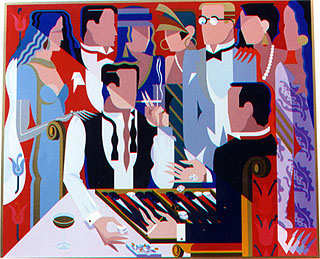|
| Magriel's NYT Columns |
 In backgammon the most important formation of men is the prime — a set of contiguous points. The most effective prime is created by owning six points in a row. A man trapped behind such a full (or six-point) prime can never escape as long as the prime remains intact.
In backgammon the most important formation of men is the prime — a set of contiguous points. The most effective prime is created by owning six points in a row. A man trapped behind such a full (or six-point) prime can never escape as long as the prime remains intact.
Also effective is a five-point prime. In order to escape with a man from behind a five-point prime, it is necessary first to move up to the point directly in front of the prime, then leap over it with a 6. For this reason, the point directly in front of the prime is often hotly contested: The player with the prime wants to make this point in order to extend it to an impassable six-point prime; the player behind the prime wants to move up to the edge of it in order to escape.
In the diagrammed position, Black has already been doubled and now has two men stuck behind White’s five-point prime (from the 20-point to the 16-point).
|
| Black to play 1-1. |
On his next roll, Black was seemingly rewarded for his play: he rolled 6-6’s and brought both his back men out. Unfortunately, Black found himself still far behind in the race and lost the game easily.
Black’s strategic thinking was faulty. He should not even attempt to escape from behind White’s prime and enter a race. Because Black is so far behind (29 pips after the play of 1-1’s), this strategy is futile. Black’s only chance is to play a holding game — that is, Black must wait and hope to hit White as he comes home.
|
|
|
By staying back, Black leaves White with an awkward gap on the 21-point. If White fails to make the 21-point, he will have great difficulty bringing his men past Black safely. Furthermore, making the 21-point will not be an easy job for White: White has an inflexible position with three men out of play deep within his home board, and so lacks the builders (spare men) with which to make this key point.
Black’s mistake in moving up to the 21-point allowed White to come home with less trouble — it relieved White of the problem of making the point and gave White greater freedom to play behind Black.
Rollout
 Tom Keith 2013 |
|
Money play Black owns 2-cube Black rolls 1-1 1296 games with VR Checker play: 2-ply Cube play: 3-ply Red |
| 1-1: | Game | G | BG | Equity | ||||
| 1 | 11/7 |
W L |
.2890 .7110 |
.0289 .0361 |
.0009 .0007 | −0.3569 |

| |
| 2 | 11/9, 8/7(2) |
W L |
.2890 .7110 |
.0286 .0361 |
.0009 .0005 | −0.3572 | (0.0003) | (b) |
| 3 | 8/7, 8/5 |
W L |
.2874 .7126 |
.0280 .0369 |
.0008 .0007 | −0.3607 | (0.0038) | |
| 4 | 11/10, 8/7, 8/6 |
W L |
.2882 .7118 |
.0290 .0383 |
.0008 .0007 | −0.3609 | (0.0040) |

|
|

